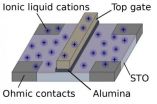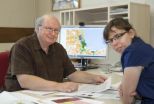(Press-News.org) As we and other vertebrates age, our DNA accumulates mutations and becomes rearranged, which may result in a variety of age-related illnesses, including cancers. Biologists Vera Gorbunova and Andei Seluanov have now discovered one reason for the increasing DNA damage: the primary repair process begins to fail with increasing age and is replaced by one that is less accurate.
The findings have been published in the journal PLOS Genetics.
"Scientists have had limited tools to accurately study how DNA repair changes with age," said Gorbunova. "We are now able to measure the efficiency with which cells in mice of different ages repair DNA breaks at the same place in the chromosome."
Gorbunova explained that when mice are young, the breaks in DNA strands are repaired through a process called non-homologous end joining (NHEJ), in which the damage is repaired by gluing the DNA together with no or very little overlap. However, Gorbunova and Seluanov found that NHEJ began to fail as the mice got older, allowing a less reliable DNA repair process—microhomology-mediated end joining (MMEJ)—to take over. With MMEJ repairs, broken ends are glued together by overlapping similar sequences that are found within the broken DNA ends. This process leads to loss of DNA segments and the wrong pieces being stitched together.
Gorbunova and her team were able to make their observations by working with genetically-modified mice whose cells produce green fluorescent protein (GFP) that glows each time the breaks are repaired. By tracking how many cells glowed green in different tissues, the researchers determined the efficiency of repair.
"We showed two things with these genetically-modified mice," said Gorbunova. "Not only did the efficiency of DNA repair decline with age, but the mice began using a sloppier repair mechanism, leading to more mutations, particularly in the heart and lungs."
DNA breaks occur frequently because animal cells are under constant assault from routine activities in the environment—whether by a blast of X-rays from a visit to the doctor or simply breathing in oxygen—and, as a result, the DNA molecules often get damaged.
Using the genetically modified mice, the research team can now look at how diet, medicines, and different genetic factors also affect DNA repair in mice.
"These mice may very well help us devise novel ways to prevent some of the illnesses associated with aging," said Gorbunova.
INFORMATION:
Less effective DNA repair process takes over as mice age
Process may explain why damaged DNA contributes to cancer and other age-related illnesses
2014-09-09
ELSE PRESS RELEASES FROM THIS DATE:
Discovery paves the way for a new generation of chemotherapies
2014-09-09
A new mechanism to inhibit proteasomes, protein complexes that are a target for cancer therapy, is the topic of an article published in the journal Chemistry & Biology. The first author of the study is Daniela Trivella, researcher at the Brazilian Biosciences National Laboratory at the Brazilian Center for Research in Energy and Materials (LNBio/CNPEM).
The findings of the study, conducted with FAPESP support in partnership with researchers from the University of California in San Diego, United States, and at the Technische Universität München, in Germany, are paving the ...
Two-dimensional electron liquids
2014-09-09
Truly two-dimensional objects are rare. Even a thin piece of paper is trillions of atoms thick. When physicists do succeed in producing 2D systems, quantum interactions can lead to new phenomena and Nobel prizes. Two examples: graphene---single-atom-thick sheets of carbon atoms---has unique mechanical, electrical, and optical properties; and two-dimensional electron gases (2DEG)---planar collections of electrons supported at the interface between certain semiconductors such as gallium arsenide---allow the observation of such emergent behaviors as the quantum Hall effect ...
Rice wireless experts tap unused TV spectrum
2014-09-09
Rice University wireless researchers have found a way to make the most of the unused UHF TV spectrum by serving up fat streams of data over wireless hotspots that could stretch for miles.
In a presentation today at the Association for Computing Machinery's MobiCom 2014 conference in Maui, Hawaii, researchers from Rice's Wireless Network Group will unveil a multiuser, multiantenna transmission scheme for UHF, a portion of the radio spectrum that is traditionally reserved for television broadcasts.
"The holy grail of wireless communications is to go both fast and far," ...
Globalization threatens benefits of an African 'green revolution'
2014-09-09
A prospective "green revolution" in Africa could boost land use and carbon emissions globally, according to a study co-authored by a University of British Columbia researcher.
The term "green revolution" typically describes the use of agricultural innovations – such as the development of new seeds – to increase yields, particularly in developing countries.
Past green revolutions in Asia, Latin America and the Middle East have spared land and carbon dioxide emissions. However, in an increasingly globalized economy, an African green revolution could lead to opposite outcomes, ...
This week from AGU: Global food trade, weather forecasting, aerosol transport
2014-09-09
From AGU's blogs: Global food trade may not meet all future demand, new study indicates
As the world population continues to grow, by about 1 billion people every 12 to 14 years since the 1960s, the global food supply may not meet escalating demand – particularly for agriculturally poor countries in arid to semi-arid regions, such as Africa's Sahel, that already depend on imports for much of their food supply, according to a new study published online in the American Geophysical Union journal, Earth's Future.
From this week's Eos: Next-Generation Forecasting of High-Impact ...
Kessler Foundation multiple sclerosis researchers find role for working memory in cognitive reserve
2014-09-09
West Orange, NJ. September 9, 2014. Kessler Foundation scientists have shown that working memory may be an underlying mechanism of cognitive reserve in multiple sclerosis (MS). This finding informs the relationships between working memory, intellectual enrichment (the proxy measure for cognitive reserve) and long-term memory in this population. "Working memory mediates the relationship between intellectual enrichment and long-term memory in multiple sclerosis: An exploratory analysis of cognitive reserve" (doi: 10.1017/S1355617714000630) was published online ahead of ...
Proactive office ergonomics can increase job satisfaction and employee retention
2014-09-09
As the amount of time employees spend at their desks increases, so does musculoskeletal discomfort and other health issues associated with the office environment. Although office ergonomics training programs have been shown to improve employee well-being and productivity, in many cases training occurs only after complaints are logged. New research to be presented at the HFES 2014 Annual Meeting in Chicago demonstrates that a comprehensive and proactive workplace ergonomics program can help to prevent discomfort and injury.
Alan Hedge, coauthor of "Proactive Office Ergonomics ...
New map tool identifies patterns of racial diversity across the US
2014-09-09
University of Cincinnati geography researchers have developed a large-scale mapping technique to track a variety of demographic data across the United States, including researching populations based on gender, race and economic diversity. Details on the technique behind the new, high resolution, grid-based map of U.S. demographics developed by Anna Dmowska, a postdoctoral fellow for UC's Space Informatics Lab, and Tomasz Stepinski, the Thomas Jefferson Chair Professor of Space Exploration at UC, are published in this month's issue of Applied Geography. The map can also ...
Gambling is just plain fun for those players who are in control
2014-09-09
People who are in control of their gambling habits play for fun and like the idea of possibly winning big. They set limits on how much money and time they can spend, and they are likely to gamble on the internet. But gambling is just one of several leisure activities these players undertake. In contrast, gambling is a form of escapism for problem players and often their only social activity, say Richard Wood of GamRes Ltd. in Canada, and Mark Griffiths of Nottingham Trent University in the UK. The results appear in Springer's Journal of Gambling Studies.
Their study is ...
1 in 5 young men unable to purchase emergency contraception
2014-09-09
September 9, 2014 -- Male shoppers in search of emergency contraception do not always have an easy time making these purchases and may be turned away at their local pharmacies. A "mystery shopper" survey conducted in New York City by researchers at Columbia University's Mailman School of Public Health and Columbia University Medical Center showed that males had a 20 percent likelihood of not being able to purchase emergency contraception. Nearly three-quarters of the pharmacies in the study created barriers for the males to get the contraception. This is the first research ...
LAST 30 PRESS RELEASES:
Air pollution exposure and birth weight
Obstructive sleep apnea risk and mental health conditions among older adults
How talking slows eye movements behind the wheel
The Ceramic Society of Japan’s Oxoate Ceramics Research Association launches new international book project
Heart-brain connection: international study reveals the role of the vagus nerve in keeping the heart young
Researchers identify Rb1 as a predictive biomarker for a new therapeutic strategy in some breast cancers
Survey reveals ethical gaps slowing AI adoption in pediatric surgery
Stimulant ADHD medications work differently than thought
AI overestimates how smart people are, according to HSE economists
HSE researchers create genome-wide map of quadruplexes
Scientists boost cell "powerhouses" to burn more calories
Automatic label checking: The missing step in making reliable medical AI
Low daily alcohol intake linked to 50% heightened mouth cancer risk in India
American Meteorological Society announces Rick Spinrad as 2026 President-Elect
Biomass-based carbon capture spotlighted in newly released global climate webinar recording
Illuminating invisible nano pollutants: advanced bioimaging tracks the full journey of emerging nanoscale contaminants in living systems
How does age affect recovery from spinal cord injury?
Novel AI tool offers prognosis for patients with head and neck cancer
Fathers’ microplastic exposure tied to their children’s metabolic problems
Research validates laboratory model for studying high-grade serous ovarian cancer
SIR 2026 delivers transformative breakthroughs in minimally invasive medicine to improve patient care
Stem Cell Reports most downloaded papers of 2025 highlight the breadth and impact of stem cell research
Oxford-led study estimates NHS spends around 3% of its primary and secondary care budget on the health impacts of heat and cold in England
A researcher’s long quest leads to a smart composite breakthrough
Urban wild bees act as “microbial sensors” of city health.
New study finds where you live affects recovery after a hip fracture
Forecasting the impact of fully automated vehicle adoption on US road traffic injuries
Alcohol-related hospitalizations from 2016 to 2022
Semaglutide and hospitalizations in patients with obesity and established cardiovascular disease
Researchers ‘listen in’ to embryo-mother interactions during implantation using a culture system replicating the womb lining
[Press-News.org] Less effective DNA repair process takes over as mice ageProcess may explain why damaged DNA contributes to cancer and other age-related illnesses



